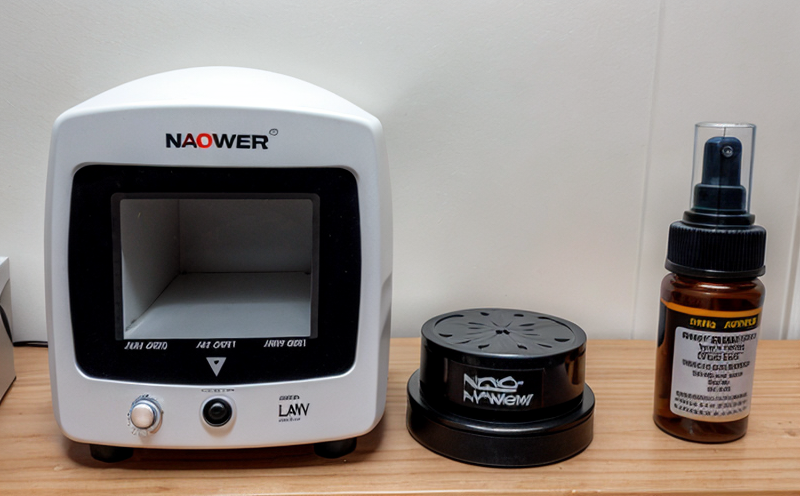ISO 9277 BET Surface Area Analysis of Nanoparticles
The ISO 9277 standard specifies a method known as the Brunauer-Emmett-Teller (BET) theory for determining the surface area of porous materials, including nanoparticles. This technique is particularly important in industries dealing with nanomaterials due to their unique properties and potential health and environmental impacts.
Nanoparticles are characterized by their small size and large surface-to-volume ratio, which can lead to different physical and chemical behaviors compared to larger particles. Understanding the surface area of these nanoparticles is crucial for optimizing product performance, ensuring safety standards, and complying with regulatory requirements.
The BET method measures the amount of gas adsorbed on a solid surface at low temperatures (typically 77 K) using nitrogen or other inert gases as adsorbents. The data obtained from this process can be used to calculate the specific surface area of the nanoparticle sample, which is essential for various applications such as catalysis, drug delivery systems, and composite materials.
The BET method relies on a linear relationship between the amount of gas adsorbed and the pressure at which it is adsorbed. This relationship allows for precise measurement even when dealing with very small particle sizes where traditional methods may not be applicable. The precision of this technique makes it an indispensable tool in nanotechnology research and development.
When analyzing nanopowders or particulates, careful sample preparation is crucial to ensure accurate results. Samples must be dispersed evenly without agglomeration to avoid errors in the measurement process. Proper sample handling also includes ensuring that all moisture content has been removed before analysis as it can interfere with the gas adsorption process.
The instrumentation used for BET surface area analysis typically consists of a vacuum system, a temperature control unit, and an adsorbent gas source integrated into a specialized instrument designed specifically for this purpose. These instruments are calibrated regularly to maintain accuracy over time.
Results from the BET method provide valuable information about not only the total surface area but also the pore size distribution of the nanoparticle sample. This comprehensive data set helps researchers and manufacturers make informed decisions regarding product design, formulation adjustments, and process improvements.
In summary, ISO 9277 BET Surface Area Analysis plays a critical role in ensuring consistent quality across nanomaterial production processes while supporting innovation within this rapidly evolving field of technology.
Why It Matters
The importance of accurately measuring the surface area of nanoparticles cannot be overstated, especially given their widespread use in modern industrial applications. Nanoparticles often exhibit properties that differ significantly from their bulk counterparts due to their high surface-to-volume ratio. Therefore, precise knowledge of these surfaces is vital for optimizing performance and ensuring safety.
For quality managers responsible for maintaining consistent product standards, understanding the surface area of nanoparticles ensures reliable batch-to-batch consistency. Compliance officers must adhere strictly to regulatory guidelines which may require documentation supporting accurate measurements. R&D engineers rely on such data when developing new products or improving existing ones by identifying optimal conditions for reactions involving nanoparticle catalysts.
From an environmental perspective, knowing the surface area helps assess potential risks associated with accidental releases into air, water, soil, etc., allowing appropriate mitigation measures to be implemented. In terms of health and safety considerations during manufacturing processes handling nanoparticles, understanding their physical characteristics aids in developing protective protocols aimed at minimizing occupational exposure.
Moreover, the precision offered by ISO 9277 BET Surface Area Analysis supports innovation by providing insights into how changes in particle size or morphology affect overall behavior. This knowledge can lead to breakthroughs in areas ranging from drug delivery systems capable of targeting specific cells more effectively than conventional treatments to advanced composite materials with enhanced mechanical properties.
Scope and Methodology
The scope of ISO 9277 BET Surface Area Analysis encompasses the determination of both total surface area (including micropores) and pore size distribution for various types of nanopowders and particulates. The methodology involves adsorption isotherms obtained through controlled exposure of the sample to a gas under defined temperature and pressure conditions.
The process begins with dispersing the nanoparticle sample uniformly in a liquid medium, such as ethanol or water, followed by drying it thoroughly before placing it into the instrument chamber. The vacuum system then reduces the internal pressure inside the chamber allowing the adsorbent gas to flow freely until equilibrium is reached.
The temperature of the sample and gas stream can be adjusted according to specific requirements set forth in the standard. Once equilibrium has been established, data points representing different pressures are collected simultaneously for both the sample and a reference material with known surface area characteristics. By comparing these values mathematically based on BET theory equations, the specific surface area of the nanoparticle sample can be calculated.
Post-processing involves plotting the obtained data to visualize trends and identify any anomalies that might indicate issues during measurement. It also allows for validation against established criteria ensuring reliability before final results are reported.
Eurolab Advantages
At Eurolab, our commitment to excellence extends beyond just performing tests; it includes providing comprehensive support throughout the entire testing process. From initial consultation regarding sample preparation through detailed explanations of results, we ensure clients receive valuable insights tailored specifically for their needs.
We employ state-of-the-art equipment calibrated according to international standards ensuring consistent accuracy across all analyses conducted here. Our experienced team comprises experts who stay updated on emerging trends within the nanotechnology field allowing us to offer cutting-edge solutions beyond basic compliance testing.
Our services are designed not only for meeting regulatory requirements but also fostering advancements in research and development. By leveraging our expertise, clients gain access to resources that can help accelerate innovation cycles and improve product quality significantly.





